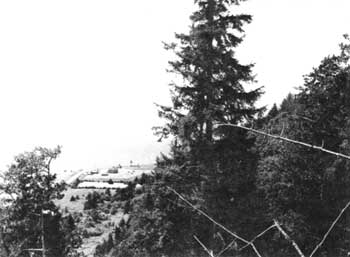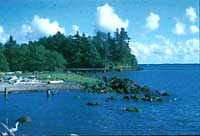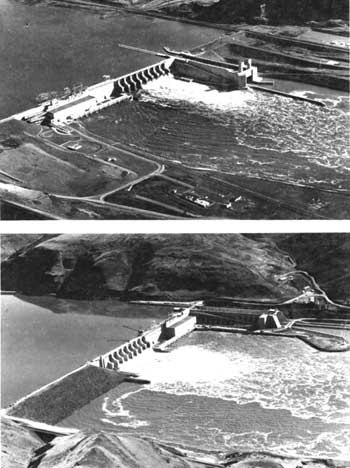






Survey of
Historic Sites and Buildings
 |
Chinook Point Campsite Washington |
 |
| ||
Two small advance parties that set out from the Point Ellice campsite on November 13 and 14 may possibly have seen the Pacific, but it is certain that Clark and the main body of the expedition first viewed it from this site along the north bank of the Columbia on November 15. Of course, 8 days earlier, from Pillar Rock, a landmark in the river some 25 miles from its mouth near present Altoona, Wash., Clark had erroneously believed he had sighted the ocean, when he was actually viewing the open-horizoned estuary of the Columbia.
 |
| Locale of the campsite at Chinook Point, occupied November 15-25,1805. From here, the explorers first saw the Pacific Ocean, in the left distance. (National Park Service (Mattison, 1958).) |
The Chinook Point campsite, established by Clark and the bulk of the complement about 4 miles west of the Point Ellice site, was the main base during the period November 15-25. Just southeast of Chinook Point, the site was located near an abandoned Chinook Indian village, whose boards were utilized for the construction of shelters. Lewis and his small group, which had set out from Point Ellice on November 14 and probed overland as far west as Cape Disappointment, returned to the Chinook Point camp on November 17. The next day, Clark and 11 men set out. Between then and the 20th, they proceeded to the cape and explored about 9 miles to its north before returning to their base.
 Chinook Point. (Charles L. Peter (National Historic Landmarks collection).) |
During all this reconnaissance, no favorable site was found for a winter camp and game was discovered to be scarce. Indians told the explorers that hunting was better on the south side of the river. On November 24 the complement voted to search there for a permanent base. The following day, in clear but windy weather, the boats cast off from Chinook Point. Because the swells were too high to permit a crossing near the mouth of the river, the craft followed the north bank upstream. Camp that night was made near Pillar Rock. The next day, November 26, at a point some 17 miles above Tongue Point, the boats crossed to the south side of the river. There, they renewed their search for a winter encampment that ended with the establishment on December 7 of a base at the Fort Clatsop site, in Oregon.
The Chinook Point campsite, designated by a State marker, is little changed from the days of Lewis and Clark. A small museum in a barracks building at nearby Fort Columbia State Park contains exhibits relating to the early exploration of the coast and to regional history.
Chinook Point, the overall geographical feature as distinct from the Lewis and Clark campsite, has been accorded National Historic Landmark status because of its associations with the era of discovery in the Pacific Northwest.
 |
| Lower Monumental (top) and Little Goose (bottom) Dams, Snake River, Wash. (U.S. Army Corps of Engineers.) |
 |
http://www.cr.nps.gov/history/online_books/lewisandclark/site40.htm
Last Updated: 22-Feb-2004